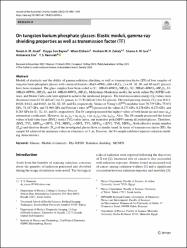On tungsten barium phosphate glasses: elastic moduli, gamma-ray shielding properties as well as transmission factor (TF)

View/
Date
2023Author
Alsaif, Norah A. M.Şen Baykal, Duygu
Elshami, Wiam
Zakaly, Hesham M. H.
Issa, Shams A. M.
Ene, Antoaneta
Rammah, Y. S.
Metadata
Show full item recordCitation
Alsaif, NAM; Baykal, DS; Elshami, W; ; Zakaly, HMH; Issa, SAM; Ene, A; Rammah, YS. On tungsten barium phosphate glasses: elastic moduli, gamma-ray shielding properties as well as transmission factor (TF). Journal of the Australian Ceramic Society (2023). 59(4), s.1095-1109.Abstract
Moduli of elasticity and the ability of gamma radiation shielding as well as transmission factor (TF) of four samples of tungsten bario-phosphate glasses with chemical formula xBaO-40WO(3)-(60-x)P2O5: (x = 10, 20, 30, and 40 mol% glasses) have been examined. The glass samples have been coded as S1: 10BaO-40WO(3)-50P(2)O(5), S2: 20BaO-40WO(3)-40P(2)O(5,) S3: 30BaO-40WO(3)-30P(2)O(5), and S4: 40BaO-40WO(3)-20P(2)O(5). Makishima-Mackenzie model, the newly online Phy-X/PSD software, and Monte Carlo code were applied to achieve the mentioned purposes. The total dissociation energy (G(t)) values were decreased from 62.58 (kJ/cm(3)) for S1 glasses to 55.92 (kJ/cm(3)) for S4 glasses. The total packing density (V-t) was 0.613, 0.626, 0.612, and 0.643, for S1, S2, S3, and S4, respectively. Values of Young's (E-MM) modulus were 76.759 GPa, 75.631 GPa, 71.167 GPa, and 71.966 GPa and Poisson's ratio (sigma(MM)) possessed the values 0.273 GPa, 0.278 GPa, 0.273 GPa, and 0.284 GPa for S1, S2, S3, and S4, respectively. The S4 sample possessed the highest values of both linear (mu) and mass (mu(m)) attenuation coefficients. However, (mu, mu(m))(S1) < (mu, mu(m))(S2) < (mu, mu(m))(S3) < (mu, mu(m))(S4). Also, The S4 sample possessed the lowest values of half value layer (HVL), tenth (TVL) value layers, and mean free path (MFP) among all studied glasses. Therefore, (HVL, TVL, MFP)(S4) < (HVL, TVL, MFP)(S3) < (HVL, TVL, MFP)(S2) < (HVL, TVL, MFP)(S1). Both effective atomic number (Z(eff)) and electron density (N-eff) of the investigated glasses have as similar trend. In terms of transmission factor (TF), the sample S4 achieved the minimum values at a thickness of 3 cm. However, the S4 sample exhibited superior radiation shielding characteristics.
Source
Journal of the Australian Ceramic SocietyVolume
59Issue
4URI
https://link.springer.com/article/10.1007/s41779-023-00900-zhttps://hdl.handle.net/20.500.12780/636

















